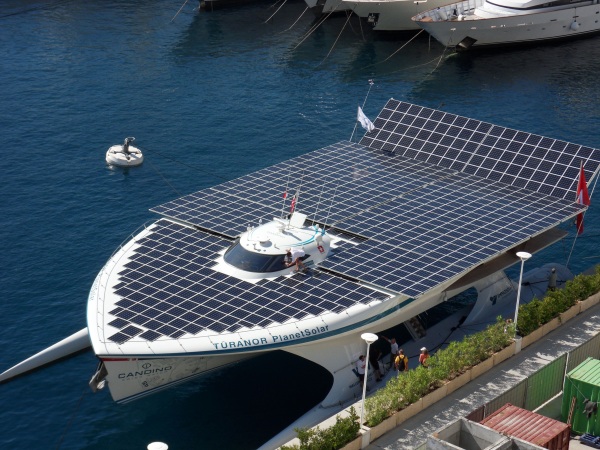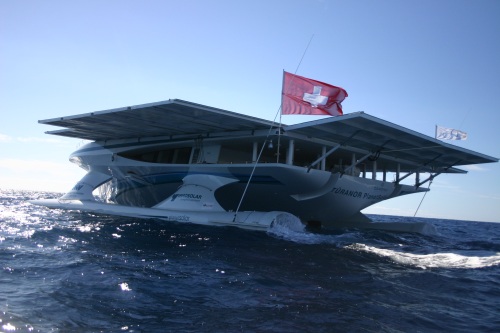
Sponsored by the Swiss government, the 115-foot, 90-ton “Turanor PlanetSolar” is the world’s largest fully solar-powered boat. It features 537 square meters of black solar panels mounted across the top, which can produce up to 500 or 600 kiloWatts per hour and retract in port but open when at sea.

The Turanor PlanetSolar is powered by more than 500 square meters of solar panels.
Last year, the $16.7 million Turanor PlanetSolar became the first solar-powered vehicle to travel around the world. The journey took 584 days, during which the boat travelled a little over 37,000 miles at an average speed of five knots. The crew had to sail as close to the equator as possible and follow routes that constantly changed, based on how much sunlight was forecasted for that day.

During its around-the-world journey, crew had to adjust the catamaran’s course based on sun forecasts.
“Twice a day we get a bulletin with sunlight forecasts. Sometimes we have to slow down to go through a patch of clouds and find a sunny spot,” said captain Erwann Le Rouzic.
Today, the catamaran is being used to study the effects of climate change on the Gulf Stream current, hence the layover in New York City. Its previous port was Miami.
“Instead of being a museum somewhere in some harbor, the boat is now engaged in this second life,” said Gerard d'Aboville, the boat's French captain, referring to the boat's latest mission.
The Turanor PlanetSolar will next stop in Boston in August, before moving on to Newfoundland, Iceland, and Norway.

The world’s largest solar-powered boat has a few more stops to make over the next few months.
“Our goal is to understand the complex interactions between physics, biology and climate . . . to refine climate simulation,” said Martin Beniston of the Institute of Environmental Sciences at the University of Geneva.
“Since the ship is powered by solar energy it does not emit any polluting substances that could distort the data collected on its 8,000-kilometer journey between Miami and Bergen, Norway,” he added.
Story via: gotoarticles.com
Images via: charterworld.com, phys.org
Advertisement
Learn more about Electronic Products Magazine





